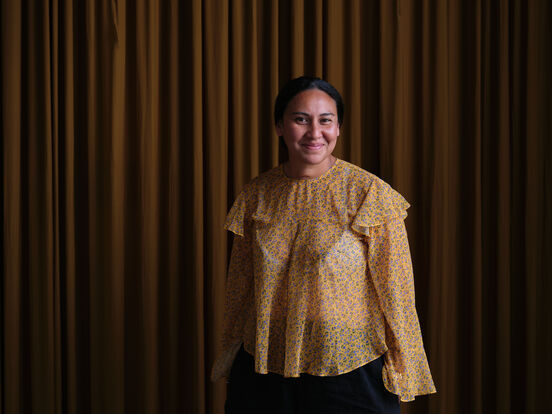Interview with Edith Amituanai
Toro Whakaara: Responses to our built environment
Edith Amituanai: Talofa, I’m Edith Amituanai. The surname is my husband’s, he is from Lalomanu. My dad is from a neighbouring village in Aleipata and my mum is from the same coast but much further up in Falelatai. I’m the child of Samoan migrants who settled in Christchurch. They met each other in Christchurch and fell in love in Christchurch and then they moved for another fresh start in Auckland. Now I’m an artist and I’m living and dying in west Auckland.
Objectspace: The exhibition was catalysed by the idea of hostile architecture. This provocation suggests that our experience of the built environment and place can be fraught – in a state of tension that prioritises some people’s needs over others’, and at odds with the natural world. Tell us more about your work for Toro Whakaara.
EA: Everyone does think about architecture – how we make space, where they live, where we rest our heads – but it’s an academic term and not a word that we use. The word I’m more familiar with is hostile. The spaces that I’ve selected to be included in the exhibition are sites that have some potential of danger. They are possibly hostile but I’m interested in the traces of human attempts or desires to overcome this hostility. There’s a tension in these things that are made because humans make these spaces hostile – but there is also beauty in that too. Like the hollowed-out, flooded quarry with the natural rock face stickered with tags – it’s dangerous yet idyllic. These images talk about a negotiation of a public and private space – they are the traces that record that activity, rather than create a portrait. Driveways, abandoned industry sites that have been commandeered for recreation, shortcuts over a creek. These sites can be made to feel private by the public. It’s not something you can read a book about. I’m seeking those locations that you need to be part of a neighbourhood to understand. I’m also interested in the impracticality of built and natural spaces and how those spaces exist in our lives. The French call them ‘desire lines’, those well-worn routes that are formed by people bypassing the prescribed path for a more natural or direct way. It’s something instinctual.
OS: What is your connection with your chosen site?
EA: Through my images I try to build up a complicated picture of a place, and this happens in spaces that are familiar to me. For this series I’ve focused on places that I know, they are in my neighbourhood. It’s an ongoing study and I’m using whatever methods work – if that means meeting with the council and talking to a civic contractor about chairs in front of the train station or talking with people who make the decisions about redevelopment. I’m approaching this image-making by looking at it from lots of different perspectives – between those who have power and those who do not. Between those people who live there and those people who actively take control of that space and reconfigure despite the way it’s been designed or controlled. When I’m photographing a place that I’m already familiar with I need to retrain myself to what I’m seeing – retrain my eyes to see it as a site that is quite interesting. On the line between public and private. I’m constantly reconfiguring how I’m seeing and how I can understand what the found architecture is trying to tell us. It’s not just how we use a space but our needs, our desires. I see these images as an artefact for the future. I’m recording the present for the future. Often I feel like an archaeologist, I’m mining the earth for present-day fossils – how we are living, or how we might live in the near future.
OS: You’ve described some of your images in relation to the street being a stage, often involving young people and how they use or modify their neighbourhoods to work better for them. What are you looking for when you take photographs?
EA: One of my favourite artists, Tina Barney, who grew up among rich WASPs on the east coast of America, created this body of work where she travelled around Europe photographing insanely opulent old-money exteriors. The locations were right up her alley but she said that if she had taken them when she was younger, she would have thrown up. I’m looking for that visceral reaction, something hard on the body. I need a physical confirmation before I can make sense of it. I’m looking for those gems, the glistening stone in the rubble. It sometimes takes me a while to find it and it’s often under my nose. That individualised find. It might look like a picture that you have already seen, a documentary photograph of a kid on the street – and it’s almost that, but it’s not that at all. Mark Adams once told me about how photographers are equally protective and obsessed with a subject they can’t share. As I get older I understand this more and more – it’s a subject only I can access, see and understand.
This text is republished from Toro Whakaara: Responses to our built environment, a publication produced by Objectspace to accompany an exhibition of the same name. The publication is edited by Tessa Forde, and copy-edited by Anna Hodge.

Portrait of Edith Amituanai. Photograph by Sam Hartnett, 2021.